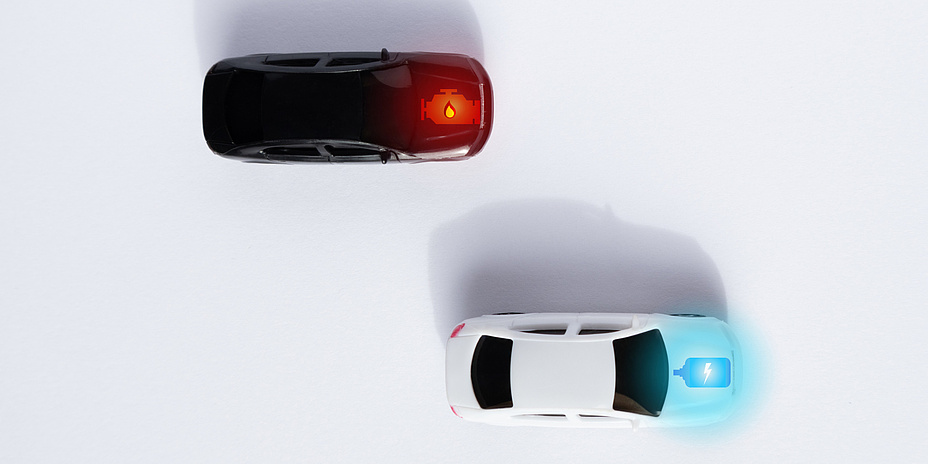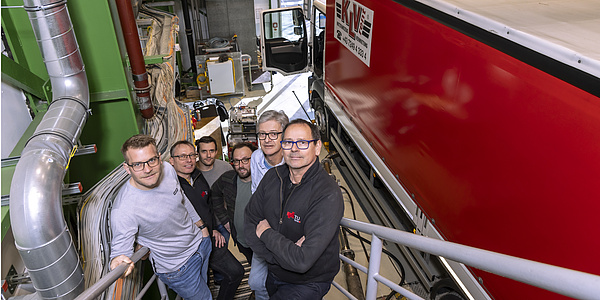“Electric cars are definitely no less safe than combustion vehicles”

News & Stories: How safe are electric cars?
Daniel Fruhwirt: Electric cars are definitely no less safe than conventional vehicles. However, in terms of firefighting, there are different challenges. This is because the battery is difficult to access. Conventional fuel such as diesel or petrol is likely to leak or burn. The battery, on the other hand, itself generates its own oxygen source. This means that I can’t simply stifle it because it can re-ignite again and again, even after a very long delay, a few days or weeks later. And that is a huge difference to the experience we have with conventional vehicles. In my view, this is why people feel insecure and therefore sceptical about electric cars. In general, however, we cannot say that battery EVs (electric vehicles) are less safe than conventional vehicles. Current statistics even show that the probability of fire is 10 times lower. There are a few uncertainties in that assessment, because there have not yet been as many incidents as with conventional vehicles, and the vehicle fleet is also not yet as old as the conventional fleet. If that ratio evens out somewhat, it will have to be re-evaluated.
How can users ensure that they are safe when travelling in an electric car?
Fruhwirt: Apart from following the normal rules for safe driving, I can only think of one important thing for drivers, and that is you have completely different acceleration values with EVs; in other words, different driving dynamics. With an EV, the power is available almost constantly, whereas with a conventional vehicle you naturally have power curves where you step on the gas and the power only sets in after a delay – you know this from the so-called diesel turbo-lag, for example. With an EV, you get the full power immediately. But from my point of view, that’s just habit. As with any new vehicle you get into, you should be more careful at first. Most of the EV fires known to date have been caused by human error. Home-made solutions used for charging and the like were to blame. The image of the entire technology suffers from such incidents.
What is the biggest danger if you have an accident with an electric car?
Fruhwirt: From a purely technical point of view, the biggest danger is that you have high-voltage components on board. This is quite different from having a 12-volt battery in the vehicle. In this case, it can be 400 or even 800 volts. That is a definite difference, although this primarily affects the emergency services. As a passenger, I am probably only really affected or in danger in very few cases. If an accident occurs and you notice that the battery is starting to react or that smoke or toxic gases are released, you just have to act quickly. A battery can react very, very dynamically. This means that the quicker you extract yourself after such an accident, the better. However, this generally applies to fire incidents, especially in tunnels, where the aim is to escape to safe areas as quickly as possible, regardless of the type of vehicle you are in.
A certain level of safety is always present in every vehicle that can be purchased
What needs to be done when an electric car catches fire?
Fruhwirt: If an EV starts burning, something needs to be done quickly. This is primarily a challenge for the emergency services, but not necessarily in terms of extinguishing the fire. The main challenge is to recognise what kind of vehicle it is. And this will become increasingly complex when you have to take even more vehicle types into account – such as hydrogen vehicles. Especially in confusing situations, you need to be able to quickly recognise the type of vehicle in order to take the right action. Apart from that, rescue teams now have a set of best practices and procedures. This is now also to be standardised at European level. In Germany there is the VDA (the German Automobile Manufacturers’ Association). They are about to publish a guideline covering the entire post-crash management. This guideline is supposed to then be standardised at EU level.
Should drivers be afraid of being struck by lightning?
Fruhwirt: In practice, no. To be theoretically in danger here, you would have to drive an electrically conductive object into the battery, so to speak. Only in an absolute worst-case scenario could metallic objects penetrate a battery in the event of a crash with massive deformation. Due to the mechanical effects, it is then probably the case that the lightning strike would already be irrelevant for the persons involved.
To what extent does the safety of an electric car have to be considered differently in terms of design than that of a combustion vehicle?
Fruhwirt: Every vehicle, regardless of whether it is a conventional vehicle, a battery vehicle, a hydrogen vehicle or any other vehicle, must meet high and standardized safety requirements in order to obtain a road licence. This means that a certain level of safety is always present in every vehicle that can be purchased. However, in the case of battery-powered vehicles, there are a few things to bear in mind. Batteries currently take up quite a lot of installation space. As a result, there is less deformable zone, especially in the event of a side impact. But a lot of research and development is being done in this area to make batteries and the entire vehicle around them crash-proof. So, I don’t see a huge disadvantage when travelling in a battery-powered vehicle. Fortunately, the level of safety is generally very high.
What are critical points of an electric car compared to a combustion vehicle?
Fruhwirt: The high-voltage battery, high-voltage components, this is definitely different to a combustion engine. On the other hand, you don’t have flammable liquid fuel on board. The bodywork itself is comparable, even though not identical. However, they are very similar in terms of fire load and other aspects. The energy source is now different. For a long time, it was primarily a liquid fuel that was the main fire load in cars. In an EV, it is the chemically bound energy in the battery cells. Stored energy is present in both, just in different forms. How much of it is released in a short time, i.e. the maximum heat release rate, can be a shade higher in a battery EV compared to a conventional vehicle. At least that’s what our tests have shown. With HGVs and buses, it’s a slightly different issue because the system structure is completely different there. With them, you have to distribute a lot of battery packs to get a certain range. Some of the batteries are also multi-storey so that enough capacity is available. This changes the deployment tactics for the emergency services, for example. But in the case of HGVs, the main fire load is not usually the energy source, but the cargo.
Gaining time is actually the main criterion for increasing safety
What has changed for the emergency services since electric cars have become a normal part of road traffic?
Fruhwirt: The procedure in the event of a fire or an accident in general. An electric vehicle normally has a circuit breaker to separate the high-voltage components from everything else. This has to be actuated. Then, you are actually safe as an emergency responder. If the vehicle is on fire, however, this makes a difference because access to the battery is difficult. There are various solutions here. For example, there are extinguishing lances that are driven into the battery. However, if the vehicle is on fire, it is unlikely that you will be able to use them. This means, that the fire will initially be conventionally extinguished, as far as that is possible. And afterwards, in order to keep it reasonably stable, the battery is flooded from the inside to prevent it from re-igniting. It must then be completely submerged in water. There are different methods for this. In Austria, container solutions are widespread and are available at fire service stations in which the vehicle is sunk. There are extinguishing lances that are pushed into the battery. There is now the Cold Cut Cobra System, with which you can cut through concrete at 400 bar pressure. This allows water to be driven in from the outside without direct contact with the battery pack.
What developments have been and are being made to ensure battery safety in electric cars?
Fruhwirt: The development work here is primarily focused on the installation situation of the battery in the car. The pack itself may already be protected in different ways and have integrated fire protection measures. For example, packs or modules are connected together in individual chambers and the chambers are separated from each other for the purposes of fire protection. Or there are at least fire protection measures between the individual blocks to prevent rapid spreading to the entire pack. This will win you some time. And time is of the essence in accident scenarios, especially in tunnels, which we deal with in a more specialised way. Gaining time is actually the main criterion for increasing safety. The way the pack is implemented in the vehicle offers potential to make the whole thing safer. A lot can be done here with the shape of the packs. The battery technology itself could be made safer, for example by using solid electrolytes. This is currently a subject of research. There are still a few challenges that need to be overcome, but this would be a significant improvement in fire safety when these types of batteries are ready for series production.
Are there any tips for electric car drivers on how to behave in the event of an accident?
Fruhwirt: In a normal minor crash without anyone being injured, as in any other road accident, there’s no additional danger. It doesn’t matter what kind of vehicle I’m travelling in. If the accident is actually so serious that the vehicle starts to burn or the battery is possibly deformed, then there is of course a risk of fire or the risk of heat or toxic substances being released. It is then important to get away from the source of the fire or the vehicle as quickly as possible. If it is still possible, it would be best to move the car somewhere safe. If this is no longer possible, you should get yourself to a place of safety. Either way, alert the emergency services and let the experts do the rest.
Kontakt
Daniel FRUHWIRT
Dipl.-Ing. Dr.techn. BSc
TU Graz | Institute of Thermodynamics and Sustainable Propulsion Systems
Phone +43 316 873 30191
fruhwirt@tugraz.at



